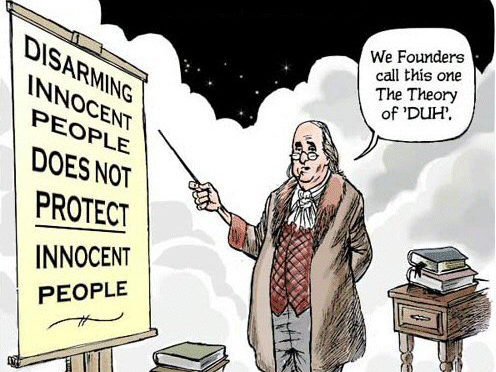My unread magazine pile was building up so I figured it was time to get caught up on several areas of interest. I was getting to some recent additions to my reading list 1st Freedom, American Rifleman, and Guns & Ammo when I was smacked in the face with an unwelcome personal reality… I was overtly conscious of whether or not someone might see what I was reading and how they might react. WHOA!
I never had a second thought about having on the table an issue of Sport Aviation, Vintage, Warbirds, Home Machinist, Mother Earth News, QST, or anything else for that matter. Why did my interest in firearms somehow make me overly concerned about other peoples opinions? What the hell was that all about?
In part, I think it has to do with living in a state that abhors guns. Its okay if I like, and own swords, bows, staves, or a wide range of other weapons, but if it even looks like a gun the P.C. wing-nuts are gonna’ rip you a new one for being some kind of anti-social, homicidal, gun-toatn’ maniac.
Sadly it’s not just the California P.C. wing-nuts that seem to have this attitude. A growing voice across the country is hell bent on taking away your and my second amendment rights. Keep in mind that this group is growing in volume, not numbers. A few people with lots of money, a platform, and personal interest (Obama & Bloomberg) are trying to rewrite the Constitution to suit their own agendas.
New rules, policies, and laws keep rolling out all over California and elsewhere, sponsored and funded by these wing-nuts, to restrict access and ownership of firearms. None of them do anything to advance safety, or protect people from stupidity, ignorance, or criminals mind you. What they do have going for them is lots of spin that make complete B.S. sound like it will save us from all the evil in the world. Many of these new rules and laws are being overturned in court because they are in fact unconstitutional.
It’s not just the unconstitutional nature of these rules and laws that frustrate me so much. It’s fact that they accomplish absolutely nothing their proponents are saying they want to accomplish. It’s all and agendized scam that has nothing to do with safety or security. They do however produce copious amounts of fear mongering and misinformation. Two examples are what has been happening with “High Capacity” magazines for handguns, and Concealed Carry permits.
The proponents of the various bans on “High Capacity” magazines for handguns want you to believe that by limiting the number of rounds in a handgun magazine to ten, rather than the eleven or thirteen, or some other arbitrary number, which are standard from the manufacturer, will some how miraculously prevent gun violence. Like the thought will cross a bad guy’s mind “I only have 10 rounds in this magazine, that’s not enough to rob that liquor store. If only I had a 13 round magazine. Oh well, I guess I’ll go play chess instead.”
One of the effects of these bans are having is that they make criminals out of otherwise law abiding citizens by not providing enough time to surrender the now illegal magazines that came with the gun, or if they forgot about a spare magazine in a box in the attic. It then adds further insult by making them go out and buy a compliant magazine, which the gun was not originally designed to hold. By the way, do you think the criminals will be surrendering their eleven or thirteen round magazines? How about postponing criminal activities while they wait for a compliant replacement magazine? Ya, didn’t think so.
Result: Criminals keep their magazines. Honest law abiding citizens surrender their magazines and wait for a back ordered replacement effectively rendering the gun useless. How does this reduce gun violence? How does this do anything beyond wasting tax dollars in surrender operations and enforcement of a ridiculous law that does nothing to improve public safety? It doesn’t.
As for Carry permits… The demands of some municipalities that a law abiding citizen provide extreme reasons why they should be allowed to apply for a Carry permit is not only unconstitutional, it is just plane dumb.
Anyone who applies for a carry permit is outright telling local law enforcement who they are, where they live, that they own weapons, they have been trained to safely carry and use them, and they wish to exercise their constitutional right to bear arms in a responsible manner. They are registering themselves with the local authorities voluntarily.
How many scoff-laws do you think apply for a Carry permit? There are always exceptions, but I have difficulty imagining a gang-banger or career criminal walking into a sheriffs office expecting to get a carry permit.
Result: Criminals do what they were going to do anyway. They illegally carry a concealed gun and local law enforcement is none the wiser. Qualified law abiding citizens are run through the ringer and denied their constitutional right to bear arms because they don’t have an extreme need to protect themselves or their families. Does this make anyone safer? Does this reduce gun violence? Absolutely not.
 I am not a gun-toatn’ homicidal maniac or a paranoid zealot. I am someone who is fascinated with the mechanics of firearms. I enjoy target shooting. I enjoy hunting for sustenance. I enjoy having the right to defend myself and my family if the need arises. These are all part of the pursuit of Life, Liberty, and Happiness. These are also part of a desire to protect and defend the Constitution from enemies, both foreign and domestic. If I choose to own or carry a gun, I am choosing to be a responsible and safe gun owner, and I am choosing to exercise my second amendment rights.
I am not a gun-toatn’ homicidal maniac or a paranoid zealot. I am someone who is fascinated with the mechanics of firearms. I enjoy target shooting. I enjoy hunting for sustenance. I enjoy having the right to defend myself and my family if the need arises. These are all part of the pursuit of Life, Liberty, and Happiness. These are also part of a desire to protect and defend the Constitution from enemies, both foreign and domestic. If I choose to own or carry a gun, I am choosing to be a responsible and safe gun owner, and I am choosing to exercise my second amendment rights.
Not everyone chooses to own firearms. Not everyone chooses to vote. These are personal decisions. These decisions should not be dictated by anyone other than the individual unless these right have been suspended by due process for criminal acts of violence.
And yes, I do hold the right to vote and the right to keep and bear arms on the same level of importance. The founding fathers did too, they are a complementary set along with the freedom of speech, each protects the other. Any agenda or policy that seeks to suspend one, should be held suspect of trying to suspend the others and cast out.
The first two rights enumerated in the Bill of Rights are the right to speak out against usurpations and the right to defend ourselves from those usurpations if the need arises. These two rights alone provide the means of ensuring that none of our rights are diminished or taken away.
This is not paranoia, it has been born out repeatedly throughout history on every continent. When people lose their right to speak out or to defend themselves effectively they are soon terrorized and subjugated.
I have always been honest about who I am, and what my position is on most subjects. Now I have expressed myself on the matter of firearms. I am passionate about this issue but I am also willing to listen to other opinions. I continue to respect others opinions even though I may fervently disagree with their position. I ask only that they respect mine in kind.
If you see an issue of Guns & Ammo on the coffee table and want to make a comment, you know where I’m coming from.
 While the changes may sound like they are a reduction of safety to non-pilots, they are in fact going to improve safety AND make flying more accessible. It should also be a boon to general aviation overall, which includes the largest segment of aviation in airmen and the number of aircraft.
While the changes may sound like they are a reduction of safety to non-pilots, they are in fact going to improve safety AND make flying more accessible. It should also be a boon to general aviation overall, which includes the largest segment of aviation in airmen and the number of aircraft.

 Yesterday was an odd day. I suppose it was odd for many Americans for a variety of reasons. The most obvious of course being the 14th anniversary of 9-11, so I didn’t notice that my post yesterday was my 200th post.
Yesterday was an odd day. I suppose it was odd for many Americans for a variety of reasons. The most obvious of course being the 14th anniversary of 9-11, so I didn’t notice that my post yesterday was my 200th post. In many ways it is analogous to the farmer. Working the soil, providing nutrients, and sewing seeds. As the farmer must wait for the seeds to germinate and grow, I have been doing other “chores” waiting for that germination and growth. Stuff around the farm that may not directly relate to that crop, but still important for the overall operation of the farm. Now it’s time to do the finishing. Harvest comes soon, some will be reaped and some let go to seed.
In many ways it is analogous to the farmer. Working the soil, providing nutrients, and sewing seeds. As the farmer must wait for the seeds to germinate and grow, I have been doing other “chores” waiting for that germination and growth. Stuff around the farm that may not directly relate to that crop, but still important for the overall operation of the farm. Now it’s time to do the finishing. Harvest comes soon, some will be reaped and some let go to seed.
 I am not a gun-toatn’ homicidal maniac or a paranoid zealot. I am someone who is fascinated with the mechanics of firearms. I enjoy target shooting. I enjoy hunting for sustenance. I enjoy having the right to defend myself and my family if the need arises. These are all part of the pursuit of Life, Liberty, and Happiness. These are also part of a desire to protect and defend the Constitution from enemies, both foreign and domestic. If I choose to own or carry a gun, I am choosing to be a responsible and safe gun owner, and I am choosing to exercise my second amendment rights.
I am not a gun-toatn’ homicidal maniac or a paranoid zealot. I am someone who is fascinated with the mechanics of firearms. I enjoy target shooting. I enjoy hunting for sustenance. I enjoy having the right to defend myself and my family if the need arises. These are all part of the pursuit of Life, Liberty, and Happiness. These are also part of a desire to protect and defend the Constitution from enemies, both foreign and domestic. If I choose to own or carry a gun, I am choosing to be a responsible and safe gun owner, and I am choosing to exercise my second amendment rights.
 Today has been a combination of studying aerodynamics in the PHAK and FAR Parts 141 and 142. One might be inclined to ask, Why?
Today has been a combination of studying aerodynamics in the PHAK and FAR Parts 141 and 142. One might be inclined to ask, Why?  As the old saying goes “when you fall off the horse, climb back on.” Well, my horse has wings. I have been sitting on the ground far too long. It’s time to climb back up and get in the air.
As the old saying goes “when you fall off the horse, climb back on.” Well, my horse has wings. I have been sitting on the ground far too long. It’s time to climb back up and get in the air.
